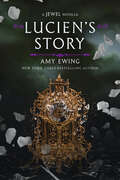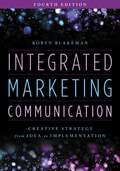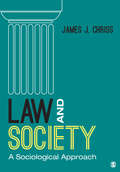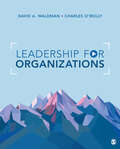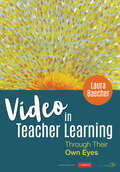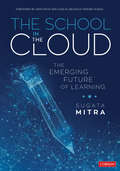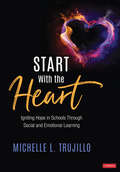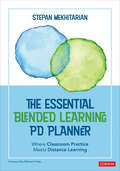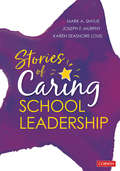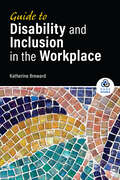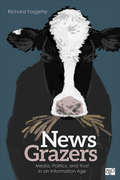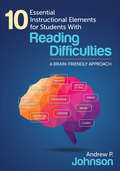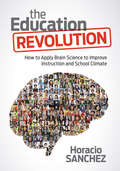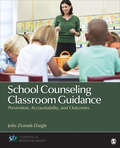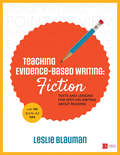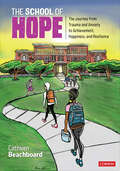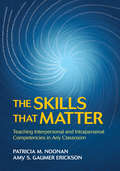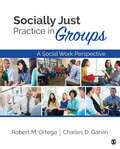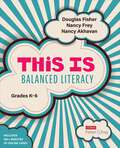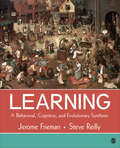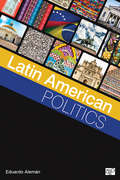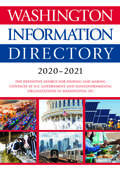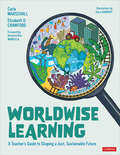- Table View
- List View
Lucien’s Story: (A Jewel Novella)
by Amy EwingReturn to the Lone City with an eagerly anticipated new story in the New York Times bestselling series that started with The Jewel. From acclaimed young adult author Amy Ewing comes the gripping tale about Lucien’s past and how he went from elite lady-in-waiting to the leader of a revolution. To save his city, he’ll have to risk everything… <P><P> Lucien’s only goal is to keep his sister, Azalea, safe from the clutches of the royalty, who rule from within the glittering walls of the Jewel. So of course, he dismisses her pleas to start a revolution and free the people of the Lone City from the royalty’s control.
Integrated Marketing Communication: Creative Strategy from Idea to Implementation
by Robyn BlakemanNow in its fourth edition, this comprehensive text offers a classroom-tested, step-by-step approach to the creative processes and strategies for effective integrated marketing communication (IMC). Robyn Blakeman covers key areas, from marketing plans, branding/positioning, and creative briefs to copywriting, design, and considerations for each major media format. Throughout, the book explores visual and verbal tactics, along with the use of business theory and practices and how these affect the development of the creative message. This user-friendly introduction walks students through the varied strands of IMC, including advertising, PR, direct marketing, and sales promotion, in a concise and logical fashion.
Digital Evidence and Computer Crime: Forensic Science, Computers, and the Internet
by Eoghan CaseyDigital Evidence and Computer Crime, Third Edition, provides the knowledge necessary to uncover and use digital evidence effectively in any kind of investigation. It offers a thorough explanation of how computer networks function, how they can be involved in crimes, and how they can be used as a source of evidence. In particular, it addresses the abuse of computer networks as well as privacy and security issues on computer networks. This updated edition is organized into five parts. Part 1 is about digital forensics and covers topics ranging from the use of digital evidence in the courtroom to cybercrime law. Part 2 explores topics such as how digital investigations are conducted, handling a digital crime scene, and investigative reconstruction with digital evidence. Part 3 deals with apprehending offenders, whereas Part 4 focuses on the use of computers in digital investigation. The book concludes with Part 5, which includes the application of forensic science to networks. New to this edition are updated information on dedicated to networked Windows, Unix, and Macintosh computers, as well as Personal Digital Assistants; coverage of developments in related technology and tools; updated language for search warrant and coverage of legal developments in the US impacting computer forensics; and discussion of legislation from other countries to provide international scope. There are detailed case examples that demonstrate key concepts and give students a practical/applied understanding of the topics, along with ancillary materials that include an Instructor's Manual and PowerPoint slides. This book will prove valuable to computer forensic students and professionals, lawyers, law enforcement, and government agencies (IRS, FBI, CIA, CCIPS, etc.). - Named The 2011 Best Digital Forensics Book by InfoSec Reviews - Provides a thorough explanation of how computers & networks function, how they can be involved in crimes, and how they can be used as evidence - Features coverage of the abuse of computer networks and privacy and security issues on computer networks
Law and Society: A Sociological Approach
by James J. ChrissThis text introduces students to the study of law from a sociological perspective by focusing on four themes: the relationship between law and society; law in everyday life; the role of race, class and gender in the legal system; and current political debates that are connected to law. While explaining the essentials elements of law, and drawing on scholarly literature and relevant cases, the author does not advocate for normative views on law and the legal system. The text compares laws across various societies, discusses international law, and demonstrates how the laws of certain countries affect those of others--providing readers with insights into the nature of law within any society.
Leadership for Organizations
by David Waldman Charles A. O′ReillyThe need to develop better business leaders has never been greater. Leadership for Organizations provides a brief overview of leadership at the individual, team, and organizational levels. Authors David A. Waldman and Charles O’Reilly expertly cover the foundational leadership approaches with a special emphasis on contemporary issues as well as visionary and strategic leadership. The text is accompanied by more than 40 video cases from Stanford Graduate School of Business’s Leadership in Focus video collection. Students learn through role-modeling as they watch real-world leaders, ranging from first-time managers to CEOs, share stories of their leadership challenges and successes. A Complete Teaching & Learning Package
Video in Teacher Learning: Through Their Own Eyes
by Laura BaecherHarness the power of video to promote reflective practice and teacher growth Video is the only feedback method that allows educators to view their teaching through their own eyes, yet many K-12 professionals have yet to reap the benefits of this powerful technology. This practical and comprehensive guide takes advantage of new methods and tools to capture teaching and learning and a broad base of current research to impact teacher thinking and actions. Written for instructional coaches, administrators, supervisors, and individual teachers, it includes guidance on how to get started and how to engage in nonjudgmental and descriptive analysis scaffolding to counter anxiety and resistance, and to cultivate a growth mindset. chapters on specific contexts including developmental, evaluative, and problems of practice. guidance for observation in specific grade bands and for specific student populations. templates and links to videos for video analysis tasks, step-by-step process outlines, real-world vignettes and application questions. Drawing on broad evidence of the impact of video on teaching, this is the guide for maximizing this powerful form of professional learning.
The School in the Cloud: The Emerging Future of Learning (Corwin Teaching Essentials)
by Sugata MitraThe Science and the Story of the Future of Learning Educators have been trying to harness the "promise" of technology in education for decades, to no avail, but we have learned that children in groups—when given access to the Internet—can learn anything by themselves. In this groundbreaking book, you’ll glimpse the emerging future of learning with technology. It turns out the promise isn’t in the technology itself; it’s in the self-directed learning of the children who use it. In 1999, Sugata Mitra conducted the famous "Hole in the Wall" experiment that inspired three TED Talks and earned him the first million-dollar TED prize for research in 2013. Since then, he has conducted new research around self-organized learning environments (SOLE), building "Schools in the Cloud" all over the world. This new book shares the results of this research and offers • Examples of thriving Schools in the Cloud in unlikely places • Mitra’s predictions on the future of learning • How to design assessments for self-organizing learning • How to build your own School in the Cloud • Clips from the documentary, The School in the Cloud Discover the future of learning by digging deep into Mitra’s thought-provoking experiences, examples, and vision.
Start With the Heart: Igniting Hope in Schools Through Social and Emotional Learning
by Michelle L. TrujilloStart with the heart to build a school climate in which achievement will flourish. You can build an empathetic school culture that promotes genuine acceptance of one another, an appreciation for diversity, and an intrinsic desire to contribute and grow academically—a school environment that is inviting, positive, and engaging! In this easy-to-read, inspiring book, educational consultant and former high school principal Michelle Trujillo shows how positive school culture is anchored in social and emotional learning as a way of being. Through explanation, personal anecdotes, and the demonstration of problem-solving through intentional connection, she guides educators to explore their own SEL aptitudes. In doing so, she inspires a schoolwide investment in a philosophy of connection—with students and each other—that ignites a climate in which every individual is seen, heard, and valued, and academic achievement has an opportunity to thrive for all. Drawing in readers through story and reflection, the book defines the challenges educators face and offers ample tools, strategies, and solutions for integrating 5 SEL competencies into schools. It includes Concrete examples of relationship-building in action in schools by modeling, integrating and explicitly teaching social and emotional learning (SEL) to students Practical, evidence-based strategies for explicit teaching of each SEL competency to students Opportunities for reflection, brainstorming, and classroom planning Stories that bring the student experience of empathetic school culture to life References to programs and practices that meet Tier 1 and 2 evidence-based curriculum requirements. Jumpstart conscientious connections in your school community and create a foundation for trust that allows students and educators to feel appreciated, effective, and productive. "This is a powerful and moving resource to inspire every educator who wants to make a difference!" – Eric Jensen, Author, Brain-Based Learning and Teaching With the Brain in Mind
The Essential Blended Learning PD Planner: Where Classroom Practice Meets Distance Learning (Corwin Teaching Essentials)
by Stepan MekhitarianForeword by Michael Fullan. "One of the best new Professional Development books." -BookAuthority Drive student learning with the best of both worlds! Transition back to school with a comprehensive PD plan that leverages the best of distance learning and classroom instruction. Distance learning, despite its myriad challenges, has spotlighted innovative instructional practices and created an opportunity to fundamentally rethink how the traditional classroom works. In this timely, crucial book, Dr. Stepan Mekhitarian constructs a framework for a task force of teachers and leaders to establish an effective blended learning program that capitalizes on the capacity and skills teachers have built while teaching remotely. An innovative blended learning model effectively implemented across school systems will positively impact equity and access for all students. In addition to Blended Learning for Social Justice sections, readers will find • Ideas for Professional Development sessions for sharing strategies and topics with teams • Distance Learning vs. Blended Learning sections to help transition various strategies between environments • Figures, templates, and tech tips to aid in implementation Learn how to create a powerful learning experience for students that fosters collaboration, engagement, and rigorous learning experiences by combining instructional technology and the best of traditional classroom practice.
Stories of Caring School Leadership
by Karen Seashore Louis Joseph F. Murphy Mark A. SmylieReal-life examples to inform and inspire caring in your leadership practices! The practice of caring is essential to effective schooling. Published as a companion to Caring School Leadership, this comprehensive resource of powerful, real-life stories will make clear the connection between caring leadership and student academic success and well-being. Stories of Caring School Leadership includes a guide for using the stories in self-directed reflection and learning, for educators practicing in schools and professional preparation programs. Readers will find stories that • will help aspiring and practicing leaders reflect upon and further develop caring as a quality of their leadership • affirm the importance of caring as a fundamental quality of school leadership • provide examples of caring school leadership in action that can be analyzed, reflected upon, and used to develop practice Stories have the power to inform and inspire. The stories in this book are evidence of what is possible when caring leadership is practiced in our schools.
Guide to Disability and Inclusion in the Workplace (SAGE Works)
by Katherine BrewardMaster the ethical and practical aspects of disability accommodation. Learn effective strategies, overcome common barriers, and build a thriving workplace for all. Real-world examples and best practices. Engage with practical scenarios and exercises. Go beyond compliance and build a culture of inclusion. Empower your workplace, unlock potential, and create a competitive edge.
News Grazers: Media, Politics, and Trust in an Information Age
by Richard ForgetteHow has growing media choice transformed the way we gather news? News Grazers: Media, Politics, and Trust in an Information Age offers students an integration of the emerging effects that cable news, online news, and social media have had on American politics. Author Richard Forgette, an expert on the U.S. Congress and public policy, draws on direct experimental research to argue that the diffusion of media outlets and media technologies has resulted in an increasingly fragmented and distracted news audience. This unprecedented level of media choice is not only altering who accesses the news and how they do it; more important, it is changing the news itself. With chapters on commentary news, partisan news, breaking news, and fake news, News Grazers gives students the tools they need to critically analyze the ever-shifting media landscape. Special attention is also paid to the effects of the media and political trust on the 2016 election.
10 Essential Instructional Elements for Students With Reading Difficulties: A Brain-Friendly Approach
by Andrew P. JohnsonBrain-friendly strategies to help all students become lifelong readers Learning to read is more than just an educational issue; it’s a social justice issue. Did you know that struggling readers are twice as likely as their peers to drop out of high school? Through time-tested, research-based neurocognitive teaching strategies, 10 Essential Instructional Elements for Students with Reading Difficulties will enable you to hone readers’ skills and help students from all grade levels develop their ability to create meaning from print. Drawing from five key areas of neurocognitive research, Andrew Johnson provides a ten-point teaching strategy that encompasses vocabulary, fluency, comprehension, writing and more. A key resource for creating intervention plans for struggling readers, features include: Information on the often-overlooked importance of emotions in the process of overcoming reading struggles Strategies to promote voluntary reading, even for the most reluctant students Useful resources such as graphic organizers, additional reading and writing activities, and QR codes that link to videos Use these strategies today and you can count on more students leaving your classrooms as fluent, lifelong readers. "Dr. Johnson tells the story of reading in a logical and clear manner with a book that is excellently researched, immaculately referenced, and full of practical tips for the practitioner." Terry Bernstein, Former Senior Literacy Difficulties Specialist London Boroughs of Camden and Westminster, UK "This is the text I wish I had when I began to teach. Dr. Johnson clearly illustrates the process our brain uses to create meaning from text." Marty Duncan, Ed.D., Author and Former Educator
The Education Revolution: How to Apply Brain Science to Improve Instruction and School Climate
by Horacio SanchezMaximizing student capacity and restoring motivation—the key to school success Brain research has the power to revolutionize education, but it can be difficult for educators to implement innovative strategies without the proper knowledge or resources. The Education Revolution bridges the gap between neuroscience, psychology, and educational practice. It delivers what educators need: concrete applications of the most current and relevant research that they can use in their classrooms and schools. Readers will find Teaching strategies based on the latest brain research, designed to advance academic performance Scientifically sound, solution-focused practices to address the root of negative behaviors Approaches to counteract the negative impact of technology on the brain Concrete methods to improve school climate Model lessons for teachers that demonstrate how to implement the given strategies Written by Horacio Sanchez, a leading authority on child and adolescent behavior and resiliency, this book shows educators how they can use our growing understanding of brain science to restore students’ desire to learn; improve achievement, behavior and school climate; and revolutionize education. "Sanchez combines expertise in education, psychology, and neuroscience with extensive teaching experience and extraordinary insight into what makes us all behave the way we do." Dr. David L. Katz, President, American College of Lifestyle Medicine Director, Yale University Prevention Research Center "The Education Revolution focuses on the whole child through both academic and social aspects of learning. I feel confident that I can trust this research and use these ideas in my teaching." Kendra Hanzlik, Instructional Coach Prairie Hill Elementary School, College Community School District
School Counseling Classroom Guidance: Prevention, Accountability, and Outcomes (Counseling and Professional Identity)
by Jolie Ziomek-Daigle"Finally, a text that thoroughly covers the topic of classroom guidance – an effective tool for every school counselor at every school level." –Tiffany Bates, Louisiana Tech University Intended for school counselors to aid in the learning of developmental classroom guidance, School Counseling Classroom Guidance: Prevention, Accountability, and Outcomes teaches the fundamentals, strategies, and research outcomes of classroom guidance programming for comprehensive, developmentally appropriate school counseling programs. The content of this book looks at the history and fundamentals of classroom guidance, how these activities meet CACREP and ASCA standards, how and why activities should be aligned to the larger academic curriculum and state/national teaching standards, recommendations on how to develop and assess classroom guidance units, a sampling of units and lessons, techniques in managing the classroom, and outcome research and trends. School Counseling Classroom Guidance: Prevention, Accountability, and Outcomes is part of the Counseling and Professional Identity Series, which targets specific competencies identified by CACREP (Council for Accreditation of Counseling and Related Programs).
Teaching Evidence-Based Writing: Texts and Lessons for Spot-On Writing About Reading (Corwin Literacy)
by Leslie A. BlaumanOne in a million. Yes, that’s how rare it is to have so many write-about-reading strategies so beautifully put to use. Each year Leslie Blauman guides her students to become highly skilled at supporting their thinking about texts, and in Evidence-Based Writing: Fiction, she shares her win-win process. Leslie combed the ELA standards and all her favorite books and built a lesson structure you can use in two ways: with an entire text or with just the excerpts she’s included in the book. Addressing Evidence, Character, Theme, Point of View, Visuals, Words and Structure, each section includes: Lessons you can use as teacher demonstrations or for guided practice, with Best the Test tips on how to authentically teach the skills that show up on exams with the texts you teach. Prompt Pages serve as handy references, giving students the key questions to ask themselves as they read any text and consider how an author’s meaning and structure combine. Excerpts-to-Write About Pages feature carefully selected passages from novels, short stories, and picture books you already know and love and questions that require students to discover a text’s literal and deeper meanings. Write-About-Reading Templates scaffold students to think about a text efficiently by focusing on its critical literary elements or text structure demands and help them rehearse for more extensive responses. Writing Tasks invite students to transform their notes into a more developed paragraph or essay with sufficiently challenging tasks geared for grades 6-8. And best of all, your students gain a confidence in responding to complex texts and ideas that will serve them well in school, on tests, and in any situation when they are asked: What are you basing that on? Show me how you know.
The School of Hope: The Journey From Trauma and Anxiety to Achievement, Happiness, and Resilience
by Cathleen BeachboardDiscover how to improve achievement, happiness, and resilience using the science of hope The current mental health crisis is driving many teachers to leave the profession while students struggle with engagement and anxiety. Trauma-informed coping mechanisms are helpful, but this book goes a step further by incorporating much-needed but often-missing support to help learners feel hopeful and provide educators with resources to care for themselves. Based on research around the psychological science of hope, this guidebook provides strategies educators and school leaders can use daily to help students feel secure, build relationships, and improve academic outcomes. Included are practices and interventions that can be woven into classrooms and schools to foster mental wellness and happiness using Classroom materials, tools, and reproducibles Scientific resources to quickly assess and monitor hope Simple plans of action to improve hope, engagement, and motivation Vignettes from classrooms and the author’s own experiences with children who have experienced extreme trauma Backed by the latest research, The School of Hope will encourage higher academic attainment and equity, inspiring a sense of deeper fulfillment for both students and educators.
The Skills That Matter: Teaching Interpersonal and Intrapersonal Competencies in Any Classroom
by Patricia M. Noonan Amy S. EricksonBuild skills for lifelong success Many students leave high school without the skills they need to succeed in postsecondary education and the workforce. How can we better equip students for lifelong success? Research demonstrates that intrapersonal and interpersonal competencies impact student behavior and achievement, increase graduation rates, and promote strong post-school outcomes. The Skills That Matter provides middle and high school educators with the resources, tools, and practical examples to teach key intrapersonal and interpersonal competencies, including self-regulation, goal-setting, self-efficacy, assertiveness, and conflict management. Readers will find Competency-specific evidence-based instructional strategies with examples, and Tools such as sample instructional plans, formative assessments, and student-friendly products. This book provides teachers with the practical information they need to better develop socially and emotionally engaged, career-equipped, lifelong learners.
Socially Just Practice in Groups: A Social Work Perspective
by Charles D. Garvin Robert M. OrtegaSocially Just Practice in Groups: A Social Work Perspective comprehensively covers all aspects of group practice in social work settings, integrating a unique social justice framework throughout. Drawing from their experience as group work practitioners, authors Robert Ortega and Charles D. Garvin walk readers through the basics of group practice, including getting started, doing group work, establishing the purpose, roles and tasks of the group, stages and phases of practice, and specific skills in assessment, monitoring, and evaluation. A social justice framework provides a fresh perspective during an era of widespread social change and provides social workers tools for effective group interventions. Chapters contain detailed case examples to illustrate concepts presented, as well as exercises to help students practice skills.
This Is Balanced Literacy, Grades K-6 (Corwin Literacy)
by Douglas Fisher Nancy Frey Nancy AkhavanThis is Balanced Literacy: Grades K-6 Students learn to read and write best when their teachers balance literacy instruction. But how do you strike the right balance of skills and knowledge, reading and writing, small and whole group instruction, and direct and dialogic instruction, so that all students can learn to their maximum potential? The answer lies in the intentional design of learning activities, purposeful selection of instructional materials, evidence-based teaching methods, and in strategic groupings of students based on assessment data. Together, these create the perfect balance of high impact learning experiences that engage and excite learners. In this hands-on essential guide, best-selling authors Douglas Fisher, Nancy Frey, and Nancy Akhavan help you define that balance for your students, lighting the path to implementing balanced literacy in your classroom. Their plan empowers you to integrate evidence-based approaches that include: • Instructional materials comprised of both informational and narrative texts. • The best uses of instructional delivery modes, including direct and dialogic instruction. • Grouping patterns that work best to accomplish learning aims for different learners at different stages. • Instruction in foundational skills and meaning making, including oral language, phonemic awareness, phonics, fluency, vocabulary, comprehension, and writing. • Technology used as a tool for increasing learning of a specific literary process. All the tips and tools you need to realize the goal of balanced literacy learning are included, with classroom videos that show strategies in action. Tap your intuition, collaborate with your peers, and put the research-based strategies embedded in this roadmap to work in your classroom to implement or deepen a strong, successful balanced literacy program. Grow as a reading and writing teacher while leading your students to grow as readers and writers.
Learning: A Behavioral, Cognitive, and Evolutionary Synthesis (Psychology Ser.)
by Jerome Frieman Stephen ReillyLearning: A Behavioral, Cognitive, and Evolutionary Synthesis provides an integrated account of the psychological processes involved in learning and conditioning and their influence on human behavior. With a skillful blend of behavioral, cognitive, and evolutionary themes, the text explores various types of learning as adaptive specialization that evolved through natural selection. Robust pedagogy and relevant examples bring concepts to life in this unique and accessible approach to the field.
Latin American Politics
by Eduardo AlemanWhile it is true that poverty, political instability, and economic under-performance continue to be major problems in Latin America, the region has made substantial progress in raising standards of living and overcoming military authoritarianism. Latin American Politics reflects just how much the region has changed in the last two decades. Eduardo Alemán draws on contemporary research in comparative studies on institutions, elections, and public opinion to highlight the big questions that political scientists seek to answer today: What are the causes of political instability? What factors have influenced changes in economic and gender inequality? What are the implications of different political institutions for political outcomes?
Washington Information Directory 2020-2021 (Washington Information Directory)
by CQ PressThe Washington Information Directory (WID) is a topically organized reference resource that lists contact information for federal agencies and nongovernmental organizations in the Washington metro area along with a brief paragraph describing what each organization does related to that topic. In addition, WID pulls together 55 organization charts for federal agencies, congressional resources related to each chapter topic, hotline and contact information for various specific areas of interest (from Food Safety Resources to internships in Washington), and an extensive list of active congressional caucuses and contact details. WID has two appendices, one with thorough information on congresspersons and committees, and the second with governors and embassies.
Learning and Memory
by Darrell S. RudmannLearning and Memory provides students with a clear, balanced, and integrated presentation of major theoretical perspectives foundational to the study of human learning and memory. Author Darrell Rudmann uses an engaging personal writing style appropriate for students with little or no previous background in psychology to discuss topics including the major behaviorism theories of learning, modern cognitive theories of memory, social learning theories, the roles of emotion and motivation in learning, and the well-established neurological underpinnings of these perspectives. A concluding chapter on learning and memory concepts in the real world shows students to how these concepts are applied in various industries, from advertising to education and the media.
Worldwise Learning: A Teacher′s Guide to Shaping a Just, Sustainable Future (Corwin Teaching Essentials)
by Carla Marschall Elizabeth O. CrawfordNautilus Gold Award Winner (Books for a Better World) in Social Sciences & Education Create inclusive, democratic classrooms that prepare knowledgeable, compassionate, and engaged global citizens. Today’s global challenges—climate change, food and water insecurity, social and economic inequality, and a global pandemic—demand that educators prepare students to become compassionate, critical thinkers who can explore alternative futures. Their own, others’, and the planet’s well-being depend on it. Worldwise Learning presents a "Pedagogy for People, Planet, and Prosperity" that supports K-8 educators in nurturing "Worldwise Learners": students who both deeply understand and purposefully act when learning about global challenges. Coupling theory with practice, this book builds educators’ understanding of how curriculum and meaningful interdisciplinary learning can be organized around local, global, and intercultural issues, and provides a detailed framework for making those issues come alive in the classroom. Richly illustrated, each innovative chapter asserts a transformational approach to teaching and learning following an original three-part inquiry cycle, and includes: Practical classroom strategies to implement Worldwise Learning at the lesson level, along with tips for scaffolding students’ thinking. Images of student work and vignettes of learning experiences that help educators visualize authentic Worldwise Learning moments. Stories that spotlight Worldwise Learning in action from diverse student, teacher, and organization perspectives. An exemplar unit plan that illustrates how the planning process links to and can support teaching and learning about global challenges. QR codes that link to additional lesson and unit plans, educational resources, videos of strategies, and interviews with educators and thought leaders on a companion website, where teachers can discuss topics and share ideas with each other. Worldwise Learning turns students into local and global citizens who feel genuine concern for the world around them, living their learning with intention and purpose. The time is now.
